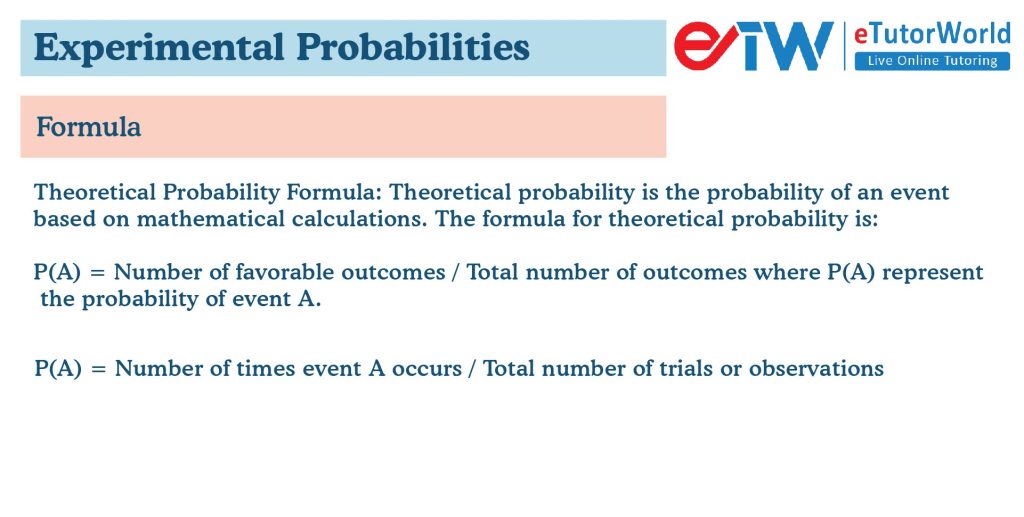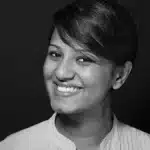Experimental Probability
Grade 7 Math Worksheets
Experimental probability refers to the probability of an event based on actual experimentation or observation of outcomes.
Table of Contents:
- Experimental Probability
- Examples
- Formula
- FAQs
Personalized Online Tutoring
Experimental Probability - Grade 7 Math Worksheet PDF
This is a free worksheet with practice problems and answers. You can also work on it online.
Sign up with your email ID to access this free worksheet.
"We really love eTutorWorld!"
"We really love etutorworld!. Anand S and Pooja are excellent math teachers and are quick to respond with requests to tutor on any math topic!" - Kieran Y (via TrustSpot.io)
"My daughter gets distracted easily"
"My daughter gets distracted very easily and Ms. Medini and other teachers were patient with her and redirected her back to the courses.
With the help of Etutorworld, my daughter has been now selected in the Gifted and Talented Program for the school district"
- Nivea Sharma (via TrustSpot.io)
Experimental Probability
Experimental probability refers to the probability of an event based on actual experimentation or observation of outcomes. It is determined by conducting an experiment or observing an event multiple times and recording the number of times the event occurs.
To find the experimental probability of an event, you would divide the number of times the event occurred by the total number of trials or observations. For example, if you flipped a coin 20 times and it landed on heads 12 times, the experimental probability of flipping heads would be 12/20 or 0.6.

Experimental probability is often used in situations where it is difficult or impossible to determine the theoretical probability of an event. It can be used to estimate the theoretical probability, but it may not be as accurate as using mathematical formulas to calculate probability.
However, experimental probability can still provide valuable information about the likelihood of an event occurring, especially if the sample size is large enough to reduce the effects of randomness and variability.
Experimental Probability Examples:
Example 1: You roll a six-sided die 100 times and record the number of times each number comes up. You find that the number 3 comes up 23 times. The experimental probability of rolling a 3 on the die is therefore 23/100 or 0.23.
Example 2: You toss a coin 50 times and record the number of times it lands on heads. You find that it lands on heads 27 times. The experimental probability of flipping heads is therefore 27/50 or 0.54.
Example 3: You draw a card from a deck of 52 cards 200 times and record the number of times you draw a heart. You find that you draw a heart 45 times. The experimental probability of drawing a heart is therefore 45/200 or 0.225.
“There have been times when we booked them last minute, but the teachers have been extremely well-prepared and the help desk at etutorworld is very prompt.
Our kid is doing much better with a higher score.”
7th Grade Tutoring
eTutorWorld offers Personalized Online Tutoring for Math, Science, English, and Standardised Tests.
Our Tutoring Packs start at just under $22.49 per hour, and come with a moneyback guarantee.
Schedule a FREE Trial Session, and experience quality tutoring for yourself. (No credit card required.)
Experimental Probability Formula
Here are some common formulas used to calculate probability:
Theoretical Probability Formula: Theoretical probability is the probability of an event based on mathematical calculations. The formula for theoretical probability is:
P(A) = Number of favorable outcomes / Total number of outcomes
where P(A) represents the probability of event A.
Experimental Probability Formula: Experimental probability is the probability of an event based on actual experimentation or observation. The formula for experimental probability is:
P(A) = Number of times event A occurs / Total number of trials or observations
where P(A) represents the probability of event A.
Conditional Probability Formula: Conditional probability is the probability of an event occurring given that another event has already occurred. The formula for conditional probability is:
P(A | B) = P(A and B) / P(B)
where P(A | B) represents the probability of event A given that event B has occurred, P(A and B) represents the probability of both A and B occurring, and P(B) represents the probability of event B occurring.
Multiplication Rule Formula: The multiplication rule is used to calculate the probability of two or more independent events occurring together. The formula for the multiplication rule is:
P(A and B) = P(A) * P(B)
where P(A and B) represents the probability of both A and B occurring, and P(A) and P(B) represent the probabilities of events A and B occurring, respectively.
Do You Stack Up Against the Best?
If you have 30 minutes, try our free diagnostics test and assess your skills.
Experimental Probability FAQS
What is probability?
Probability is a measure of the likelihood of an event occurring. It is represented as a number between 0 and 1, where 0 represents an impossible event and 1 represents a certain event.
What are the types of probability?
There are two main types of probability: theoretical probability and experimental probability. Theoretical probability is based on mathematical calculations, while experimental probability is based on actual experimentation or observation.
What is conditional probability?
Conditional probability is the probability of an event occurring given that another event has already occurred. It is calculated using the formula P(A | B) = P(A and B) / P(B), where P(A | B) represents the probability of event A given that event B has occurred.
What is the difference between independent and dependent events?
Independent events are events in which the occurrence of one event does not affect the probability of the other event occurring. Dependent events are events in which the occurrence of one event affects the probability of the other event occurring.
What is the law of large numbers?
The law of large numbers states that as the number of trials or observations increases, the experimental probability of an event approaches its theoretical probability. This means that with a large enough sample size, the experimental probability becomes more accurate.

Gloria Mathew writes on math topics for K-12. A trained writer and communicator, she makes math accessible and understandable to students at all levels. Her ability to explain complex math concepts with easy to understand examples helps students master math. LinkedIn
Affordable Tutoring Now Starts at Just $22.49
eTutorWorld offers affordable one-on-one live tutoring over the web for Grades K-12. We are also a leading provider of Test Prep help for Standardized Tests (SCAT, CogAT, MAP, SSAT, SAT, ACT, ISEE, and AP).
What makes eTutorWorld stand apart are: flexibility in lesson scheduling, quality of hand-picked tutors, assignment of tutors based on academic counseling and diagnostic tests of each student, and our 100% money-back guarantee.
Whether you have never tried personalized online tutoring before or are looking for better tutors and flexibility at an affordable price point, schedule a FREE TRIAL Session with us today.
*There is no purchase obligation or credit card requirement
Grade 7 Science Worksheets
- Elements and Compounds
- Solar Energy
- Photosynthesis
- Electricity and Magnetism
- Law of conservation of energy
- Periodic table
- Properties of Matter
- Waves
- Energy Resources
- Weather and Climate
- Immune, Circulatory and Digestive Systems
- Organs in Multi-cellular Organism
- Sedimentary, Igneous, and Metamorphic Rocks
- Structure of the Earth
- Law of Conservation of Mass
- Physical and Chemical Changes
- Scientific Method
- Human Digestive System
- Environmental Science
- Renewable and Non-renewable energy Resources
- Characteristics of Living Organisms
- Life Science
- Earth and Space Science
- Solar Eclipse
- Heat Technology
- Newton’s Laws of Motions
- Physical Science
- Tools, Measurement and SI Units
- Earth Atmosphere
- Interactions of Living things
- The Earth Ecosystem
- Organelles in Plant and Animal cells
- Layers of the Earth
- Cycles in Nature
Grade 7 Math Worksheets
- Fractions
- Linear equations word problems
- Statistics
- Properties of Parallel Line
- Finding slope from an equation
- Identifying Quadrilaterals
- Percent Change
- Properties of addition and multiplication
- Pythagorean Theorem
- Solving two step inequalities
- Symmetry
- Fractions to Decimals (New)
- Whole Number Exponents with Integer Bases (New)
- Adding and Subtracting Fractions (New)
- Integer Addition and Subtraction (New)
- Dividing Mixed Numbers (New)
- Basics of Coordinate Geometry (New)
IN THE NEWS

Our mission is to provide high quality online tutoring services, using state of the art Internet technology, to school students worldwide.
Online test prep and practice
SCAT
SSAT
ISEE
PSAT
SAT
ACT
AP Exam
Science Tutoring
Physics Tutoring
Chemistry Tutoring
Biology Tutoring
Math Tutoring
Pre-Algebra Tutoring
Algebra Tutoring
Pre Calculus Tutoring
Calculus Tutoring
Geometry Tutoring
Trigonometry Tutoring
Statistics Tutoring
Quick links
Free Worksheets
Fact sheet
Sales Partner Opportunities
Parents
Passive Fundraising
Virtual Fundraising
Our Expert Tutors
Safe and Secure Tutoring
Interactive Online Tutoring
After School Tutoring
Elementary School Tutoring
Middle School Tutoring
High School Tutoring
Home Work Help
Math Tutors New York City
Press
©2022 eTutorWorld Terms of use Privacy Policy Site by Little Red Bird
©2022 eTutorWorld
Terms of use
Privacy Policy
Site by Little Red Bird









